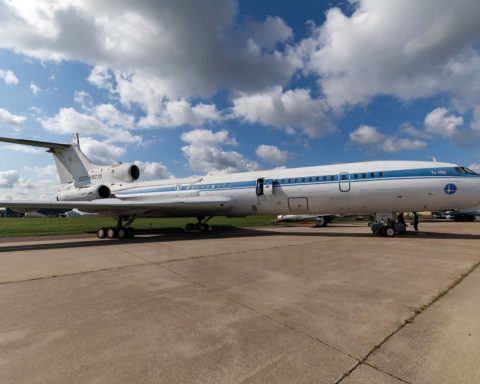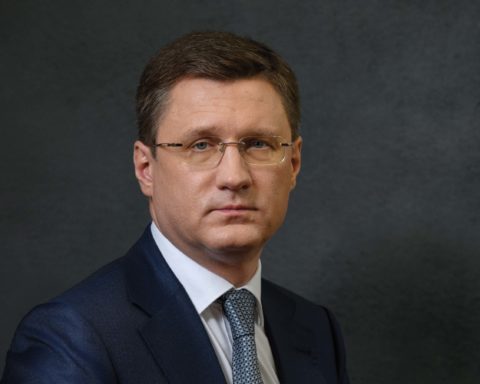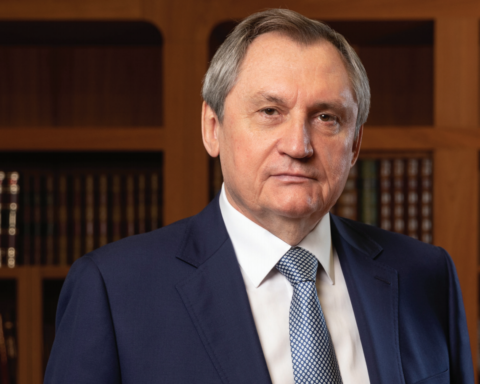Denis Valentinovich Manturov, the Minister of Industry and Trade of Russia
Commentary in the First Person
The sanctions imposed by the USA and other developed countries have confronted Russia with the fact that the critical areas of the economy, such as the oil and gas industry, require complete self-sufficiency and independence. The total amount of the government support in solution of the Russian oil-and-gas machine building development tasks until 2024 will be more than 30 billion rubles. As a result, Russia shall develop its own technologies for offshore and onshore survey, exploration vessels and production platforms, as well as a modern fleet for oil and LNG (liquified natural gas) transportation.
E.P.: Due to the sanctions foreign equipment has to be substituted with the Russian one. What is the total share of foreign equipment used for exploration, oil and gas production, LNG production and processing?
D.V. Manturov: According to the action plan approved by Minpromtorg (the Ministry of Industry and Trade of the Russian Federation) on the basis of government decisions, in general, the dependence on imported equipment in the oil and gas industry has to be decreased up to 45% this year and up to 43% by the end of 2020, while in 2014 the level of oil and gas equipment import dependency was 60% for the entire industry.
For example, the share of imported equipment for the enhanced oil recovery, including the equipment for directional and horizontal drilling of the wells, currently has been decreased up to 45%, the share of equipment for oil refining – up to 43%, the share of equipment for LNG production and shelf projects implementation – up to 50%, the share of exploration equipment – up to 30%.
E.P.: What is the total expected amount of investment in the development of oil and gas sector import-substitution technologies until 2024–2035?
D.V. Manturov: As it has been initially estimated, the amount of the government support for the Russian oil-and-gas machine building development until 2024 will be more than 30 billion rubles. This is in general, within the framework of corporate competitiveness programs implementation, Industrial Development Fund loans, projects support through the unified aid grant for R&D, financing of manufacturing the equipment for medium- and large-scale LNG production and for hydraulic fracturing.
E.P.: What are the areas of the most concern with respect to imported equipment substitution? How is the issue of technologies for seismic survey and complex drilling (multi-hole, multi-stage) being addressed?
D.V. Manturov: With regard to the most challenging areas for import substitution, perhaps, first of all it is worth paying attention to the technologies for offshore exploration and subsea production systems. We need both a consolidated demand and a strength of technological and production competencies of Russian enterprises to meet this challenge. Minpromtorg has established a scientific and technical council for the development of oil and gas equipment; it consists of the expert groups dealing with technologies and equipment for exploration, shelf projects, as well as subsea production facilities.
Since 2016 we have allocated about 2 billion rubles for top-priority offshore exploration experimental development. The funds were spent on the design of the recording system with a gel-filled tow streamer, systems for its positioning, bottom cables, bottom stations. As a result, the main package of seismic and electrical survey equipment, which can be used on the Arctic shelf, has become available. By the way, the system efficiency has been already tested with the participation of Gazprom Neft and such oil service companies as Sovcomflot Geo, MAGE and Rosgeologia.
Of course, a lot of work is expected in this area. In 2019, Minpromtorg entered into contracts with the state authorities; upon their implementation we are planning to produce not only the prototypes, but also off-the-shelf equipment for scaling instead of its foreign analogues. This will be a packaged system with 12 km long towed gel-filled streamer and seismic source points, acoustic and mechanical positioning systems, a mobile hardware and software system for marine seismic survey in transit zones and in the shelf area. I hope that by 2021 we will have conducted all the tests in Arctic conditions and will have produced competitive industrial systems.
E.P.: Among the greatest challenges you have mentioned the development of domestic technologies for subsea production facilities. What is the progress of the equipment design in this area? Is there currently any demand for subsea production facilities with due regard to the price? Are there any chances to switch to the domestic equipment in this area?
D.V. Manturov: In fact, today`s market of the equipment for subsea production represents an oligopoly of three American and one Norwegian companies: FMC Technologies, General Electric, OneSubsea (all of them are the USA companies); Aker Solutions (a Norwegian company). And we have to be completely self-sufficient and independent in such critical areas taking into account all the sanction “cases” of the recent years.
The consolidated demand of LUKOIL, Gazprom, Rosneft for the equipment to be designed under the State program for the development of shipbuilding and machinery for shelf exploration is amounted to about 300 units of subsea facilities until 2035. As you probably know, as early as in 2017, we signed a cooperation agreement with Gazprom to develop prototypes of the equipment for subsea production facilities, defined 12 top-priority R&D projects and prepared technical requirements for them. Today, in total almost 3.5 billion rubles have been allocated for them under the State program. By the end of the year, we expect the reports from the executors who carried out the works on the prototypes.
E.P.: In the meanwhile, the experts note that a major challenge with respect to the import substitution in the oil and gas industry is the lack of vessels capable of producing 3-D seismic. Are there any options for addressing this issue?
D.V. Manturov: We know how to build vessels, we understand how to do it and we have the necessary competencies. The experience of some world’s seismic vessel companies shows that their projects have been implemented based on the upgrade of supply vessels. The main components which we still do not have in full scope are the instruments and software for their equipping. Another task to be solved is the development of the software system for communication and correct operation of the vessels and various seismic equipment. Some of them will be designed upon implementation of three resource works in 2021, others have still to be developed.
E.P.: But it’s not just the software, but also, for example, the lack of the vessels equipped with 12, 24 streamers for seismic survey, is it?
D.V. Manturov: Indeed, the products which are currently used are supplied by foreign manufacturers. The Russian streamers will be available in 2021, and after that the dialogue with consumer companies regarding their use on the Russian vessels can be opened. The situation with 2D and 3D bottom stations is different; already today there is Russian equipment which is used by MAGE in commercial production operations for Gazprom Neft.
E.P.: The Russian seismic vessel market is solidly occupied by Chinese companies. Does it have sense to introduce protectionist measures for the benefit of domestic companies?
D.V. Manturov: As for protectionist measures, one should be always careful with them and first analyze whether they will not have an adverse effect for the Russian companies developing shelf fields and trying to comply with their license obligations.
The dialogue with Russian service companies should be conducted to convince them to purchase Russian equipment, and to convince Vertically Integrated Oil Companies to include it into their technical specifications for works and to provide preferential advantage when it is used. Today the major oilfield service players in the area of offshore seismic survey are Rosgeologia, MAGE and Sovcomflot Geo.
E.P.: What is the status of manufacturing the platform drilling heads, which are still being ordered in Japan and Korea, and what is the status of manufacturing the ice-class drilling platforms? Have relevant proposals been prepared to be submitted to the government? Is the solution already available?
D.V. Manturov: For the development of domestic industry, of course, it would be good to know the plans of our oil and gas companies for their field facilities construction specifying the deadlines, however, currently they sometimes do not know themselves when and where this or that platform will be installed. Therefore, the joint work, which we constantly carry out is very important; for instance, since 2016 we have been dealing with the issue of the platform drilling heads in cooperation with oil and gas companies. We have studied the main drilling equipment, which is not available in Russia and which should be developed almost from scratch; as a result, we have generated a list including about 200 items. The R&D works for 12 of them will be carried out in the near future so that we could outfit the platform heads with the Russian equipment.
E.P.: Are the plans for introduction obligations in oil and gas exploration and production licenses for predominantly Russian equipment still in force? How will oil and gas exploration be affected by this?
D.V. Manturov: We try our best to include them in onshore exploration and production licenses where justified. For example, as part of the bidding procedure for the use of Khambateyskoye field being approved by Rosnedra (Russian Federal Agency on Subsoil Use), Minpromtorg sent the message regarding the need to include the preferential use of the equipment satisfying the demands of government decree No. 719 in the requirements to the content of the bidding documents.
E.P.: What is the status of import substitution with respect to manufacturing LNG equipment? What is the share of foreign equipment, the reduction potential?
D.V. Manturov: In cooperation with NOVATEK and Gazprom we analyzed the demand until 2035 and established a list of the top-priority areas, the implementation of which would allow Russian manufacturers to master the manufacturing of a wide range of LNG equipment by 2023.
The financing of the development will be carried out as part of a universal aid grant for R&D works based on the advanced technologies; we anticipate that the procedure for its provision will be approved by the government at the beginning of 2020. For all the required testing of the equipment to be designed and manufactured, it is expected to build the facility for cryogenic testing, the construction contractor has been already selected: this will be Rosatom State Atomic Energy Corporation.
With reference to LNG, I cannot help mentioning the work being carried out at the same time with the equipment designing and manufacturing under the program for standardizing the advances in technologies and techniques in the area of natural-gas liquefaction and subsea production systems for the development of offshore oil and gas fields; by 2022 we have to produce 300 state standards in line with it.
As part of the roadmap for localization of the equipment for medium- and large-scale LNG production, an agreement of intent between Rosneft, Gazprom and NOVATEK stipulating cooperation between the parties in terms of technologies and equipment development has been worked out.
This agreement covers the supply of Russian equipment developed under the new R&D support program, which will be executed since 2020.
E.P.: What is the progress of the works for the construction of gas tankers, which are carried out by Zvezda shipyard and by the South Korean Samsung as part of Arctic LNG-2 project? Is it planned to work with Samsung in the same manner for the other potential projects, for example, in order to provide the vessels for the Northern Sea Route?
D.V. Manturov: As you know, shipbuilding complex “Zvezda” is currently under construction: the works under the first stage of the project are in progress. According to the agreement which was signed between Zvezda and Samsung Heavy Industries during the Eastern Economic Forum this year, the Korean company shall be a technological partner under the project and shall deliver the technical specification and grant the rights to the design documentation to the Russian plant. Lazurit Central Design Bureau shall develop the detailed design documentation with the support of Samsung Heavy Industries. It is notable that the vessels will be under the Russian company control and will be registered under the Russian flag; this will fully comply with the requirements of the Merchant Shipping Code and Russia’s interests.
We use the opportunities of international cooperation in the construction of large ice-class LNG carriers to facilitate the potential development of domestic design bureaus and plants, and I do not exclude the extension of this cooperation with the world’s leading shipbuilding facilities in the future.
E.P.: Was it possible to completely abandon the idea of zeroing import duties on imported LNG carriers, as it was suggested by Novatek?
D.V. Manturov: In my opinion, the introduction of additional preferential conditions for the use of foreign vessels can already have a negative impact on the competitiveness of domestic vessels, and such a decision shall be made only on the basis of the appropriate feasibility studies. Today Russian companies are already receiving substantial support for the development of the competitive LNG production in our country. Let me remind you that in March the government authorized the marine transportation of gas and gas condensate produced in Russia using the vessels sailing under the foreign flags.
E.P.: What new proposals for supporting Arctic-class vessels, including those ones associated with the launch of the Payakhsky project and the development of the Northern Sea Route, are being prepared by Minpromtorg?
D.V. Manturov: Basically, for shipbuilding development we use both general purpose state-supported and industry-specific mechanisms and financial instruments. Today the list of supporting measures, also in the interests of transport companies operating in the Arctic region, is quite long and sufficient for creating indispensable conditions for running the existing projects as well as for deployment of the new ones. A significant importance in this issue is given to the support of import-substituting projects targeted at the designing and manufacturing civil ships and vessel accessories.
E.P.: When will it eventually be possible to switch to the target indicators for 90% import substitution? Why are the products of Russian projects more expensive than their foreign analogues? What should be done to improve the situation?
D.V. Manturov: In accordance with the strategy for the development of shipbuilding industry for the period up to 2035, which was approved at the end of October, by 2035 we have to reach 75% domestic share indicator in the cost of the finished domestic product; 100% import substitution indicator is far from being always economically feasible and achievable in the current market and international cooperation conditions. At the same time, in comparison with foreign analogues, characterized primarily by large-scale deliveries and other economic conditions of the production, Russian projects implemented as part of the import substitution program are often more expensive at the first stage, however, in the course of commercial production and development their potential, including the export potential, and competitiveness, including the price competitiveness, will be growing.






